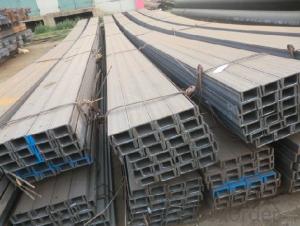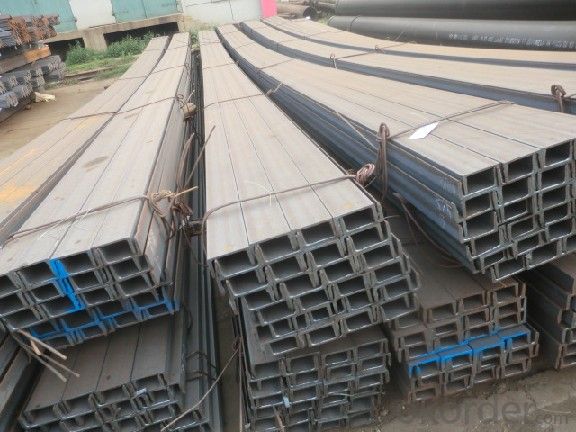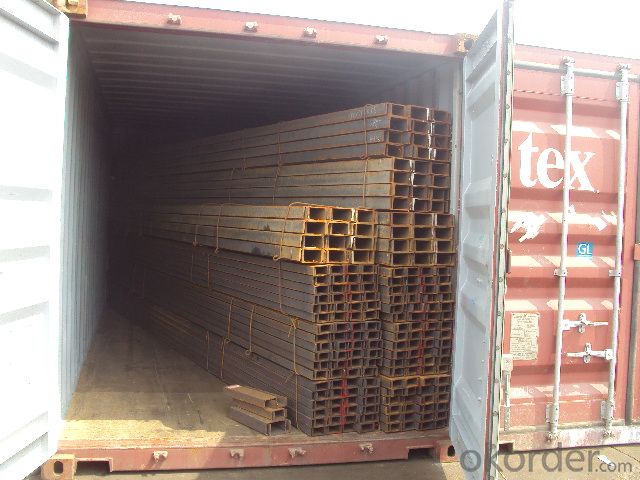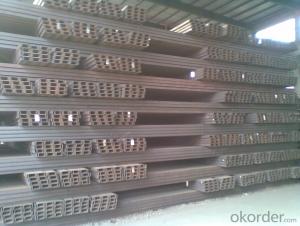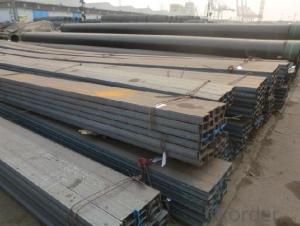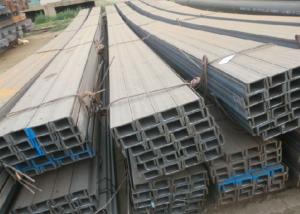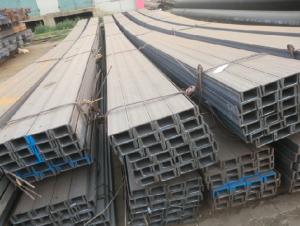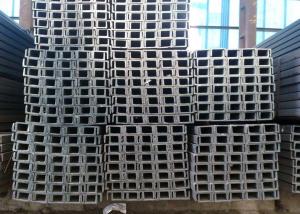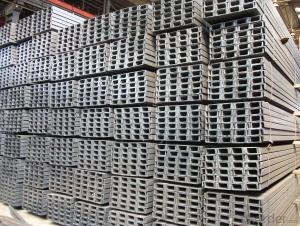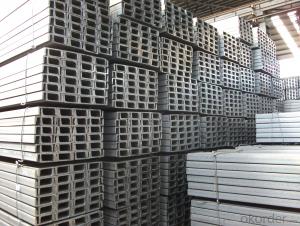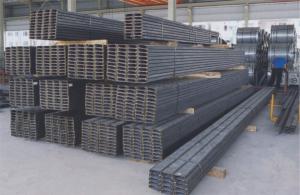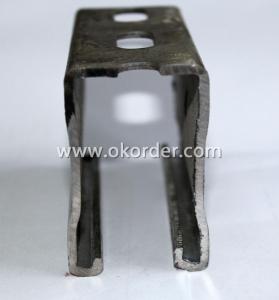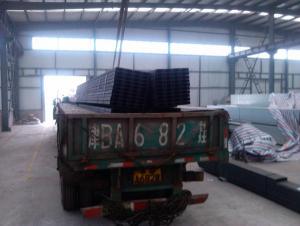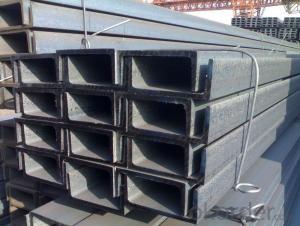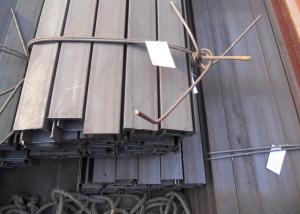channel
- Loading Port:
- China Main Port
- Payment Terms:
- TT OR LC
- Min Order Qty:
- -
- Supply Capability:
- -
OKorder Service Pledge
OKorder Financial Service
You Might Also Like
Product Description:
Specifications of MS Channel:
1.We supply high quality MS Channel at reasonable price, including Chinese standard, Japanese standard and so on.
Standard | GB/JIS |
Material Grade | Q235,SS400 |
Technique: | Hot Rolled |
Sizes as per chinese standard: | 50*37*4.5mm - 300*89*11.5mm |
Sizes as per japanese standard: | 50*25*3mm – 200*80*7.5mm |
Length: | 6meter, 9meter, 12meter |
Note: 1.we are also competent to provide our customers other MS Channel based on other sizes according to customer’s requirements.
2. The length of our ms channel could be cut into other meters as per customer’s requirements. For example, the channel in 6meters could be cut into 5.8meters in order to be fit in the 20ft container.
2. The detailed sections of MS Channel as per GB standard.are shown in the table-1:
GB U CHANNEL | Standard | Sectional | Dimension |
| Mass: |
| (mm) | (mm) | (mm) | (mm) |
|
50X37 | 50 | 37 | 4.50 | 7.0 | 5.438 |
63X40 | 63 | 40 | 4.80 | 7.5 | 6.634 |
80x43 | 80 | 43 | 5.00 | 8.0 | 8.045 |
|
|
|
|
|
|
100x48 | 100 | 48 | 5.30 | 8.5 | 10.007 |
120x53 | 120 | 53 | 5.50 | 9.0 | 12.059 |
140x58 | 140 | 58 | 6.00 | 9.5 | 14.535 |
140x60 | 140 | 60 | 8.00 | 9.5 | 16.733 |
|
|
|
|
|
|
160x63 | 160 | 63 | 6.50 | 10.0 | 17.240 |
160x65 | 160 | 65 | 8.50 | 10.0 | 19.752 |
|
|
|
|
|
|
180x68 | 180 | 68 | 7.00 | 10.5 | 20.174 |
180x70 | 180 | 70 | 9.00 | 10.5 | 23.000 |
|
|
|
|
|
|
200x73 | 200 | 73 | 7.00 | 11.0 | 22.637 |
200x75 | 200 | 75 | 9.00 | 11.0 | 25.777 |
|
|
|
|
|
|
220x77 | 220 | 77 | 7.00 | 11.5 | 24.999 |
220x79 | 220 | 79 | 9.00 | 11.5 | 28.453 |
|
|
|
|
|
|
250x78 | 250 | 78 | 7.00 | 12.0 | 27.410 |
250x80 | 250 | 80 | 9.00 | 12.0 | 31.335 |
250x82 | 250 | 82 | 11.00 | 12.0 | 35.260 |
|
| |
|
|
|
280x82 | 280 | 82 | 7.50 | 12.5 | 31.427 |
280x84 | 280 | 84 | 9.50 | 12.5 | 35.823 |
280x86 | 280 | 86 | 11.50 | 12.5 | 40.219 |
|
|
|
|
|
|
300x85 | 300 | 85 | 7.50 | 13.5 | 34.463 |
300x87 | 300 | 87 | 9.50 | 13.5 | 39.173 |
300x89 | 300 | 89 | 11.50 | 13.5 | 43.883 |
Table-1
3. The chemical composition of HR Channel Steel according to Q235B is shown in Table-2.
Alloy No | Grade | Element(%) | ||||
C | Mn | S | P | Si | ||
Q235 | B | 0.12-0.20 | 0.3-0.7 | ≦0.045 | ≦0.045 | ≦0.3 |
Table-2
Note: we are able to present our customers relevant SGS test report for chemical composition of HR Channel Steel.
4. The mechanical property of HR Channel Steel according to Q235B is shown in Table-3-1 and Table-3-2
Alloy No | Grade | Yielding Strength Point(Mpa) | |||
Thickness(mm) | |||||
≦16 | >16-40 | >40-60 | >60-100 | ||
≧ | |||||
Q235 | B | 235 | 225 | 215 | 205 |
Table-3-1
Alloy No | Grade | Tensile Strength(Mpa) | Elongation After Fracture(%) | |||
| | Thickness(mm) | |||||
≦16 | >16-40 | >40-60 | >60-100 | |||
≧ | ||||||
G235 | B | 375-500 | 26 | 25 | 24 | 23 |
Table-3-2
Note: we are able to present our customers relevant SGS test report for mechanical property of MS Channel as customer’s request.
Applications of MS Channel:
The MS Channel can be applied to construction of warehouses, workshops, sport stadiums and car parks etc.The hot rolled channel steel belongs to carbon structural steel which is applied to in the field of construction and machinery.In details, the hot rolled channel steel is usually used for arch-itechtural structure, and they could be welded in order to support or hang a vari-ety of facilities. They are also usually used in combination with I beam. Generally,the hot rolled channel steel we supply must possess perfect welding property, riveting property and mechanical property and so on.
Package & Delivery of MS Channel:
1.The hot rolled channel steel will be packed in bundle with steel wire at each end of every bundle and color marking in order to help the customer to recognize his goods more easily at sight.
2. And the hot rolled channel steel could be loaded into 20ft or 40ft container, or by bulk cargo.If the weight of each bundle reaches more than 3.5 mt, the loading by break bulk cargo should be choosed.When the weight of each bundle reaches less than 3mt, the loading by container should be choosed.
3.As for the transportaion from mill to loading port, the truck will be usually used. And the maximum quantity for each truck is 40mt.
4.All in all, we could do in accordance with customer's request
- Q: Cautions for surface zinc spraying on channel steel
- Thermal spraying zinc sacrificial anode protection is a single layer of zinc, the corrosion rate depends only on the zinc layer thickness and dissolution rate and inorganic zinc in addition to the protection of zinc layer, the complex chemical changes generated by lithium silicate, zinc silicate, carbonate can better cover metal surface. Secondly, the high porosity of thermal sprayed zinc (3% ~ 5%), another blocking agent brushing waterborne inorganic zinc rich coating with low porosity (usually below 1%), which can be used for thermal spraying zinc surface sealants. In addition, the process of thermal spraying zinc complex, need for high temperature and high pressure and inorganic zinc spraying, brushing is can be flexible operation, the overall comparison, but low cost inorganic zinc.
- Q: Can steel channels be used in airport terminal construction?
- Indeed, airport terminal construction does utilize steel channels. These channels, renowned for their robustness and resilience, are frequently employed in construction endeavors, including the creation of airport terminals. Their primary function is to offer structural support, serving as frames, reinforcements, and fulfilling diverse roles throughout the construction of these terminals. Steel channels are particularly favored in airport terminal construction due to their ability to withstand substantial burdens, rendering them apt for supporting sizable structures and guaranteeing the safety and stability of the terminal edifice. Moreover, steel channels can be effortlessly fabricated and installed, facilitating proficient construction procedures within airport terminal projects.
- Q: What are the maintenance requirements for steel channels?
- The maintenance requirements for steel channels typically involve regular cleaning to remove dirt and debris, as well as preventing corrosion by applying protective coatings or paint. Additionally, regular inspections should be conducted to identify any signs of damage or wear, and necessary repairs or replacements should be made promptly.
- Q: What kind of welding rod used for channel steel?
- Electrode used to see the material, Q235-A election J422, Q345 election J506... The thickness of channel section
- Q: Is the channel 20 the same as the channel 20b?
- No, channel 20, a and B two.20A specifications are: 200*73*7.0, weight per meter is 22.637kg20b specifications are: 200*75*9.0, weight per meter is 25.777kg
- Q: How do steel channels contribute to the stability of industrial structures?
- Steel channels contribute to the stability of industrial structures by providing structural support, distributing loads evenly, and increasing overall strength. They are commonly used as beams or columns to resist bending, deflection, and torsion forces, ensuring the stability and integrity of the structure. Additionally, steel channels allow for versatility in design, making it easier to construct complex structures while maintaining stability and safety.
- Q: Can steel channels be used in mezzanine floors?
- Yes, steel channels can be used in mezzanine floors. Steel channels, also known as C-channels or U-channels, are commonly used as structural elements in construction. They are versatile and can provide strength and support for mezzanine floors. Steel channels can be used as joists or beams to create the framework for the mezzanine floor, providing a sturdy and durable structure. Additionally, steel channels can be easily customized and fabricated to meet specific design requirements, making them suitable for various mezzanine floor applications.
- Q: Can steel channels be used for both residential and commercial applications?
- Steel channels have a wide range of applications, both in residential and commercial settings. They are versatile and durable components that can be utilized in various construction projects. In residential settings, steel channels can be employed for framing walls, supporting ceilings, and creating structural supports for staircases and balconies. They are also commonly utilized in commercial settings, including warehouses, factories, and office buildings. With their excellent strength and load-bearing capacity, steel channels are suitable for projects of different sizes and complexities in both residential and commercial sectors. Moreover, their resistance to corrosion and fire makes them highly suitable for both types of applications.
- Q: Are steel channels suitable for high-traffic areas?
- Yes, steel channels are suitable for high-traffic areas. Steel is a durable and strong material that can withstand heavy foot traffic and is resistant to wear and tear. Additionally, steel channels provide structural support and stability, making them ideal for areas with frequent and heavy use.
- Q: Classification, use and material of channel steel
- Channel steel is divided into ordinary channel steel and light channel steel. Standard Specification for hot-rolled plain channel steel is 5-40#. Specifications for hot rolled flexible channel steel supplied by supply and demand agreement are 6.5-30#.
Send your message to us
channel
- Loading Port:
- China Main Port
- Payment Terms:
- TT OR LC
- Min Order Qty:
- -
- Supply Capability:
- -
OKorder Service Pledge
OKorder Financial Service
Similar products
Hot products
Hot Searches
Related keywords
